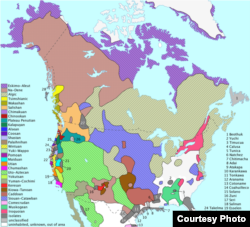Latin is considered a "dead" language because it has ceased to evolve, but millions of people study it in school. That's because Latin pops up in medicine and law and is the root of many words in Spanish, Portuguese, French, Romanian and English.
So there's dead, like "Latin dead," and really dead - completely obliterated, never to be spoken again, like hundreds of the early languages of the Americas.
Or written, either, because almost none of them were written in the first place. The tribes that spoke them disappeared entirely or adopted their region's dominant English or French. So elders stopped speaking their language and handing it down to the young.
But there's work afoot to revive many of these dead languages, and not just for sheer academic pleasure. Revitalizing old tongues is a matter of pride. Witness the success of reclaiming Hebrew - once used only for prayer and study - as the national language of Israel. It’s now spoken every day by millions of people.
That certainly can’t be said for Latin, outside of churches, anywhere in the world.
Rediscovering lost languages can be useful, as when scholars were able to reconstruct enough of the long-dead Virginia Algonquian language that the native characters could speak it credibly in a 2005 movie called "The New World."
But reviving an old, dead language is tough work, especially with no scrolls, no storybooks, no grammar lists - no written language at all - to go by. When it comes to Amerindian tongues, experts must rely on the crude notes of European settlers, who took a stab at writing down a few words as they heard them spoken, then spelled the words as they pleased.
According to expert linguists, more than 500 of the estimated 800 Amerindian languages are dying since only a few elders speak them. Or those tongues are dead and gone.
This is not just an American problem. The Smithsonian Institution's senior linguist, Ives Goddard, estimates that - without a concerted effort to save them and teach them to the young - half the world's 6,000 surviving languages will be extinct within this century.
Or "mortuus," as we'd say in Latin - if we spoke it anymore.
So there's dead, like "Latin dead," and really dead - completely obliterated, never to be spoken again, like hundreds of the early languages of the Americas.
Or written, either, because almost none of them were written in the first place. The tribes that spoke them disappeared entirely or adopted their region's dominant English or French. So elders stopped speaking their language and handing it down to the young.
But there's work afoot to revive many of these dead languages, and not just for sheer academic pleasure. Revitalizing old tongues is a matter of pride. Witness the success of reclaiming Hebrew - once used only for prayer and study - as the national language of Israel. It’s now spoken every day by millions of people.
That certainly can’t be said for Latin, outside of churches, anywhere in the world.
Rediscovering lost languages can be useful, as when scholars were able to reconstruct enough of the long-dead Virginia Algonquian language that the native characters could speak it credibly in a 2005 movie called "The New World."
But reviving an old, dead language is tough work, especially with no scrolls, no storybooks, no grammar lists - no written language at all - to go by. When it comes to Amerindian tongues, experts must rely on the crude notes of European settlers, who took a stab at writing down a few words as they heard them spoken, then spelled the words as they pleased.
According to expert linguists, more than 500 of the estimated 800 Amerindian languages are dying since only a few elders speak them. Or those tongues are dead and gone.
This is not just an American problem. The Smithsonian Institution's senior linguist, Ives Goddard, estimates that - without a concerted effort to save them and teach them to the young - half the world's 6,000 surviving languages will be extinct within this century.
Or "mortuus," as we'd say in Latin - if we spoke it anymore.








